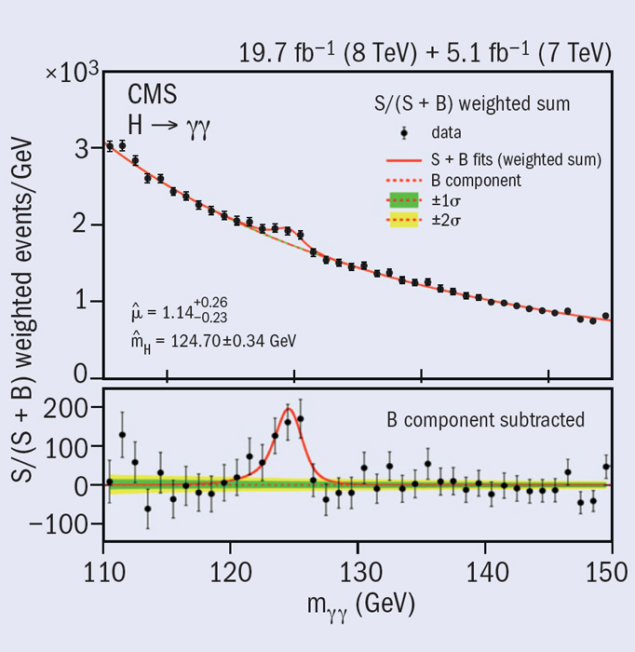The CMS collaboration achieved an important milestone this summer with completion of the analysis of the last of the five main channels that contributed to the discovery of a Higgs boson in July 2012. The subsequent measurements of the particle’s properties are now complete.

The results of the final analysis in the decay channel into a photon pair, H → γγ, were presented at the 2014 International Conference on High Energy Physics in Valencia and, at the same time, submitted for publication (CMS 2014a). This is one of the two Higgs-decay channels – the other being H → ZZ → four leptons – that have very good mass resolution and therefore allow the unquestionable detection of the Higgs boson and the precise measurement of its mass. However, H → γγ is probably the most difficult decay to exploit at the LHC. It requires a great deal of effort on the optimization and calibration of the electromagnetic calorimeter for photon identification and energy measurement, as well as highly sophisticated analysis methods designed to beat the large backgrounds from sources other than the Higgs.
The first preliminary results on the full Run 1 data were presented by CMS in March 2013. Since then, a large amount of work has gone into all aspects of the analysis: the understanding of the energy scale for photons was greatly improved, exclusive selections addressing all possible production processes were deployed, and major improvements in the statistical treatment of the background estimation were achieved. All of these changes have led to an increase in sensitivity of approximately 25% and to a reduction of the systematic uncertainty in the mass measurement by a factor three.
The analysis is based on various multivariate discriminants that are mainly used to separate events into a total of 25 exclusive categories that not only increase the sensitivity but also allow measurement of the different production processes for the Higgs boson in the H → γγ channel alone. The expected final sensitivity for the observation has increased from 4.2σ for the preliminary result to 5.2σ. The data show a 5.7σ excess at the Higgs boson mass of 125 GeV, therefore providing the definitive observation of the Higgs boson in the diphoton decay channel alone.
The final results of the analysis indicate that the yield of diphoton decays relative to the predictions of the Standard Model (the signal strength modifier) is 1.14+0.26–0.23 – in very good agreement with the Standard Model. In addition, the mass of the Higgs boson is measured to be 124.70±0.34 GeV – the most precise measurement to date.
The figure shows the combined weighted diphoton mass distribution, where a large excess in the region of 125 GeV is clearly visible. The publication presents a host of additional measurements, including the signal-strength modifiers associated with different production mechanisms, direct upper bounds on the Higgs boson width, the search for quasi-degenerate states decaying into two photons, and a spin analysis.
CMS also performed a preliminary combination of these results with the previously published results for the other channels (CMS 2014b). The overall signal strength from this combination is found to be 1.00±0.13, again in striking agreement with the predictions of the Standard Model.
Further reading
CMS Collaboration 2014a arXiv:1407.0558 [hep-ex] submitted to Eur. Phys. J. C.
CMS Collaboration 2014b CMS-PAS-HIG-14-009.





